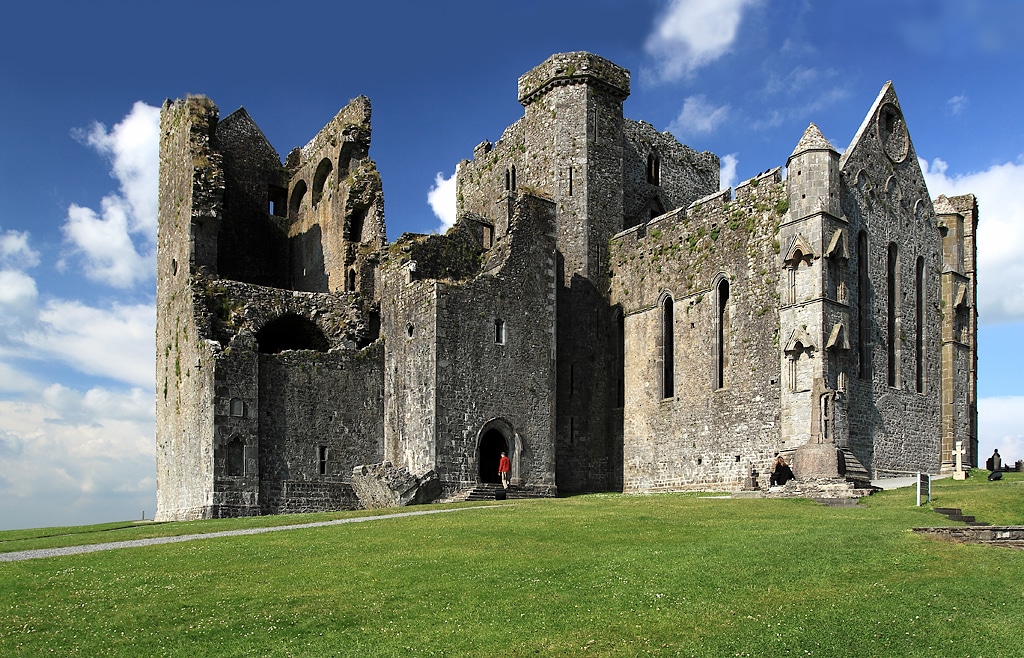Rock Cashel
Fascinating and the keeper of legends, the Rock of Cashel, often referred to as St. Patrick’s Rock, is one of the most important archaeological sites on the Island.
The structure resembles a fortress, precisely in reference to its ancient function as a bulwark of Celtic resistance against the Christianization of the area. Evocative and enchanting, the Rock of Cashel is located in County Tipperary, not far from Dublin.
On top of the Rock of Cashel, stands an impressive archaeological complex surrounded by ancient fortifications. Mighty walls protect a round tower, an abbey lacking its roof structures, and the ruins of the archbishop’s see, built on top of considerably older settlements. At the center of the complex is the Gothic cathedral, still only partially covered by its vaults.

All around the fortress of Cashel an expanse of green bordered by Celtic crosses. It was customary to carve graves out of the ruins of ancient churches, almost like symbolism in a seemingly random order. In Cashel, Ireland, this custom lasted until about 1984. Against this almost fairy-tale backdrop is St. Patrick’s Rock, which remains one of the major tourist attractions.
The history of the saint tidies up and reconstructs early records dating back to the fourth century. The papers tell of the Eoghanachta clan, who chose the Rock of Cashel as their base of support. Some members coming from Wales on the conquest of Munster became lords of the region. And it was the bishop who was responsible for their Christianization in the next century. His mission began by converting the clan leader, Aengus.
The Rock of Cashel became St. Patrick’s Rock. In the 10th century, the Rock of Cashel was conquered by the O’Briens, and in 1101, King Muircheartach O’Brien made a donation to the Church. The devious purpose was to ingratiate himself with the powerful local ecclesiastical circles and to prevent the rival clan, the Eoghanachta, from regaining the Rock.
The troubled fortunes of the Rock of Cashel, saw the fortification pass from hand to hand. In 1647, during the Irish Confederate Wars, the sacking fell to Oliver Cromwell’s English army, led by Murrough O’Brien. Later, in the early 18th century, the Protestant Church took it over for about twenty years, transforming St. Patrick’s Rock into a place of worship. The roof of the abbey was removed in 1749 by order of the then Bishop of Cashel of the Church of Ireland (Anglican), Arthur Price. Collapse followed, but restoration was never carried out.
The history of the Saint makes order and reconstructs the earliest records dating back to the 4th century. The papers tell of the Eoghanachta clan, who chose the Rock of Cashel as their base of support. Some members coming from Wales on the conquest of Munster became lords of the region. And it was the bishop who was responsible for their Christianization in the next century. His mission began by converting the clan leader, Aengus.
The Rock of Cashel became St. Patrick’s Rock. In the 10th century, the Rock of Cashel was conquered by the O’Briens, and in 1101, King Muircheartach O’Brien made a donation to the Church. The devious purpose was to ingratiate himself with the powerful local ecclesiastical circles and to prevent the rival clan, the Eoghanachta, from regaining the Rock.
The troubled fortunes of the Rock of Cashel, saw the fortification pass from hand to hand. In 1647, during the Irish Confederate Wars, the sacking fell to Oliver Cromwell’s English army, led by Murrough O’Brien. Later, in the early 18th century, the Protestant Church took it over for about twenty years, transforming St. Patrick’s Rock into a place of worship. The roof of the abbey was removed in 1749 by order of the then Bishop of Cashel of the Church of Ireland (Anglican), Arthur Price. Collapse followed, but restoration was never carried out.
Of the patron saint of Ireland are the legends of St. Patrick that enrich his reputation as a preaching bishop. There is the reference to snakes, or the legend of the well and the legend of Downpatrick Head. At Cashel there is another noteworthy story that we intend to tell in some way. In this place, the Christian had a fight with the devil. An unholy and very human fight.
The legend of the spit mountain
Legend has it that the rock where the fortress was built is a piece of mountain ‘spit out’ by the devil, after he swallowed it during a battle with St. Patrick. Some, claim that the boulder fell from his mouth at the sight of the bishop, who came to the site during an evangelization itinerary.
The legend of the staff
Another belief has it that the rock was given to the church by a pagan Irish king through the work of St. Patrick. During the king’s baptism, the saint accidentally pierced a foot of the ruler with his crozier, who – believing it was part of the ritual as a test of courage – grabbed the mythical staff and pierced his foot.
So this is Rock Cashel…it’s a fantastic castle in ireland that is full of story and legends…